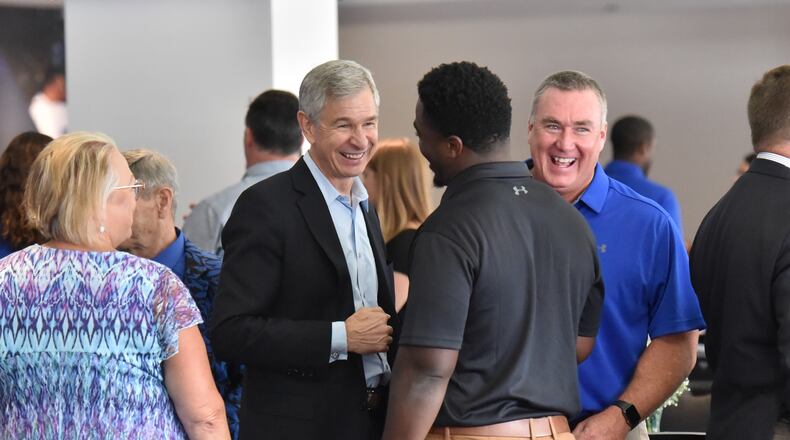Georgia State University President Mark Becker stared out the window of his office in downtown Atlanta on a recent afternoon. The view included student housing and other tall buildings, some that didn’t exist when he was hired a decade ago.
The university, through the construction of several new dorms and the acquisition and renovation of Turner Field, is one of the city’s largest landowners having transformed the downtown landscape. It now offers 250 majors and minors, making it a critical education, business and employment component in the city and the region. Its $1.15 billion total budget is only behind the University of Georgia and Georgia Tech among state schools.
On his mind was the central question: What’s the future for the state’s largest university?
During his tenure, Georgia State has become the 10th-largest public university in the nation, with nearly 53,000 students spread over its main campus downtown and two-year Perimeter College campuses around the metro area. Faculty research spending has more than doubled to over $200 million a year. Georgia State, by some accounts, graduates more nonwhite students than any school in America.
As he looked out the window, Becker said there’s still much to do. In recent months, he’s met with faculty, administrators and students to plot out the path forward for Georgia State. The fall semester starts in a week.
His goals include improving graduation rates, particularly at its Perimeter College campuses.
Credit: HYOSUB SHIN / AJC
Credit: HYOSUB SHIN / AJC
"We're not there because if we admit a student, they should graduate," Becker said. Georgia State's overall six-year graduation rate ranks fifth within the state's University System, at 63%. Perimeter's graduation rate is 15%.
Other goals include increasing faculty racial diversity and completing a student housing and retail project near what was once Turner Field, now Georgia State Stadium. Winning more football games is on the wish list, too.
Students, faculty and higher education experts have their own wish list: Hire more faculty for the Perimeter campuses. Offer more career counseling to undergraduate students. Improve the financial aid process. Support a community plan that includes education programs and offers scholarships to students who live near the stadium. Be innovative.
Georgia State, once labeled a “commuter school,” has changed. The expectations are greater. Jennifer Lee, higher education analyst for the Georgia Budget and Policy Institute, wonders if Georgia State is ready.
“I’m curious to see how Georgia State University rises to that challenge, or not,” she said.
The student experience
Becker, previously the provost at the University of South Carolina, arrived at Georgia State in 2009 saying he wanted to continue the work of his predecessor, Carl V. Patton. For Becker, that included improving faculty research opportunities and creating more academic programs.
Georgia State accepts about 52% of the students who apply, a higher percentage than University of Georgia or Georgia Tech. The tuition is less expensive, part of the draw for prospective students. Here, A’s and B’s are the most frequently awarded grades, according to its annual factbook. That doesn’t mean the coursework is easy, said rising senior Nashbi Grand-Jean.
“Tough,” is how he described it.
Grand-Jean, 21, who’s studying journalism with a minor in political science, said he’s thrived at Georgia State. He grew up in Jonesboro and said he got straight A’s one semester for the first time since fourth grade.
>> READ | Georgia State’s Mark Becker urges schools to help overlooked students
Grand-Jean, who served in the university student senate, credits networking opportunities on campus for getting him internships in the offices of Georgia Gov. Brian Kemp and Attorney General Chris Carr.
He has some ideas about how Georgia State can be better. Consider opening a medical school. Improve school pride.
"There's not a sense of 'Go Panthers!,' " said Grand-Jean, referring to the university's nickname.
The student newspaper chronicled the lack of fan support at football games in an article last year.
Georgia State is still fragmented in some ways. There are more dorms, but students say there’s not enough green space to connect the downtown campus and bring students together. Students who live off campus say once they leave campus, it’s hard returning, even for a football game. Georgia State, though, has the second-highest student activity athletic fees in the University System, $275 a year.
On a recent morning, junior Yan Pimentel Cotta was at the downtown student center, in a blue Georgia State T-shirt, to greet new students as part of a program welcoming them to campus. Cotta, 21, originally from Brazil, said he hoped to discuss career development with the students, something he believes the university should do more intentionally during orientation and in classes.
“They encourage students to graduate, which is good,” said Cotta, a political science major who is considering a career in international law. “But (students) are not being trained to go into the (labor) market.”
The Perimeter consolidation
Georgia State embraced an unconventional approach several years ago to improve student performance. Becker, who has a doctoral degree in statistics, and his team used data to closely study when students were in trouble, a method called “predictive analytics.” The university offered additional counseling and coaching and grants, if necessary, to struggling students to help them graduate. Georgia State’s six-year graduation rate rose nearly 6 percentage points during Becker’s first four years. Educators and philanthropists like Bill Gates came, curious to see how this works.
The approach has been somewhat different at Perimeter. In some ways, Perimeter has been Becker’s biggest challenge.
The state's Board of Regents consolidated Perimeter with Georgia State's main campus in 2015, creating the largest enrollment in the state. The decision worried some educators who feared Perimeter, which had been sanctioned by its accrediting agency before the consolidation for financial instability, would not get the same resources as the main campus.
At Perimeter, Becker and his team have put groups of 25 first-year students together in the same set of four or five courses. The idea is for those students to familiarize themselves with the coursework and excel.
Georgia State believes that approach is working. Nearly 60% of Perimeter students either earned their associate degrees or transferred to bachelor's degree programs, a record percentage, the school says. Since consolidation, Perimeter College's three-year graduation rate has improved from 6.5% to 15%.
Elizabeth West, who taught at Perimeter as a graduate student, says Perimeter has improved, but she’s worried the workload is too heavy for faculty. About one-quarter of Georgia State’s full-time faculty taught at Perimeter in 2017. That year, more than one-third of Georgia State’s enrollment — nearly 19,000 students — were at Perimeter.
“We have to get real with what faculty can do effectively,” said West, who teaches in the English department on the main campus.
Becker said he plans to hire more faculty at Perimeter, particularly for science and technology courses. He’s also exploring what the school can do to improve its online course offerings.
Next steps
While 75% of Georgia State’s students are nonwhite, about 70% of its full-time faculty are white, university data shows. Becker said the disparity has been a long-standing concern for him.
West, who joined the faculty in 2001, said she’s heard from students of color eager to be mentored by faculty who look like them and can advise them about navigating race-related issues in the work world. She believes the university can improve the numbers by recruiting more nonwhite students to pursue doctoral degrees at Georgia State, which is often a pathway to hiring faculty. Becker will announce a plan to address the topic next month.
Tanya Washington, another Georgia State professor, is hopeful Becker will revisit another issue: getting the university to support a plan providing better housing, educational, and employment benefits for residents who live near the stadium. Washington, who lives in the area, Peoplestown, is in litigation with the city of Atlanta over its plans to use eminent domain to take some land for a sewage retention pond and park.
Credit: HYOSUB SHIN / AJC
Credit: HYOSUB SHIN / AJC
Washington said she and others want the university and a developer to consider a plan completed in 2016 that includes committing $20 million for affordable housing for low-income residents, a scholarship fund for neighborhood students, job training, early childhood education and resources for residents at risk of losing their homes due to property tax increases. The area’s unemployment rate is about twice the city average, the community plan says.
“Longtime residents are concerned about the sharp increase in property taxes, rising rents and code violation citations. They see a lot of expensive homes being built and they see development projects that don’t include affordable housing and they are feeling anxious about whether they will be able to remain in the neighborhoods they know and love,” said Washington, who teaches education and family law and has been at Georgia State since 2003.
>> RELATED | Turner Field neighbors hopeful, skeptical about area’s transformation
“All is not lost,” Washington said. “The expansion continues and the community needs continue.”
Becker spoke positively about the project. A locally owned barbecue restaurant, an ice cream parlor, a coffee shop and a pizza place have opened along Georgia Avenue in the shadow of the stadium. A privately owned student dorm is set to open this semester.
“Employment of residents from those neighborhoods by Georgia State has increased, enrollment of students from those neighborhoods in Georgia State has increased, crime has decreased, and economic vitality is returning to the area,” Becker said.
Credit: HYOSUB SHIN / AJC
Credit: HYOSUB SHIN / AJC
Becker confessed he’s sometimes unsure about his own vision for the school’s future. For example, one day, he believes Georgia State will soon run out of space downtown. The next day, he said he’s more optimistic there’s room to grow.
Under Becker’s watch, Georgia State has benefited from a national economic recovery. Its total budget has nearly doubled. The good fortune may soon shift.
University System leaders and national experts expect a future decline in college enrollment. Lee, the Georgia Budget and Policy Institute analyst, wonders how Georgia State will adapt if some economists are right that a recession is on the horizon. Kemp recently ordered all state agencies to propose ways to tighten spending.
Becker is optimistic about Georgia State’s future. He’s looking for the “signals and trends” to determine what should be next for the university. He is, after all, a trained statistician.
MEMORABLE MOMENTS
Key dates in Mark Becker’s Georgia State tenure:
Oct. 30, 2008 — Becker, then provost at the University of South Carolina, is hired to lead Georgia State.
January 2009 — Becker takes the helm as Georgia State’s president.
May 18, 2009 — The university lays off 30 employees and eliminates a total of 300 positions to make up for state budget cuts.
Sept. 2, 2010 — Georgia State starts its football program, a 41-7 victory over the Shorter Hawks.
May 8, 2014 — Georgia State announces plans to buy Turner Field and create a mixed-use complex near the former Atlanta Braves ballpark.
Jan. 6, 2015 — The state’s Board of Regents approves the consolidation of Georgia State and Georgia Perimeter College, making it the largest school in the state.
Jan. 5, 2017 — The Turner Field acquisition is completed.
GEORGIA STATE UNIVERSITY
BY THE NUMBERS
52,814 — fall 2018 enrollment
52% — the acceptance rate
$1.15 billion — the current total fiscal year budget
250 — the number of majors, minors and pathways
$26,646 — average cumulative debt upon graduation
2,127 — students majoring in biological science, the top degree major
$1,129,002.90 — President Mark Becker’s current annual compensation
Sources: 2017-18 Georgia State University Factbook, University System of Georgia
About the Author
Keep Reading
The Latest
Featured







